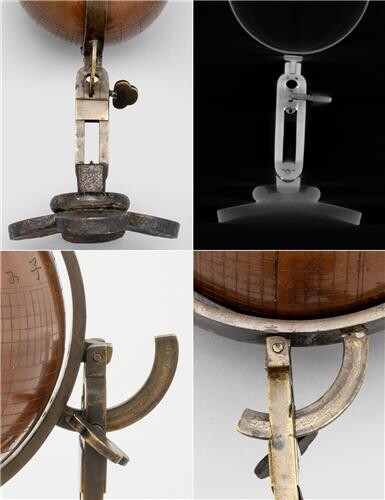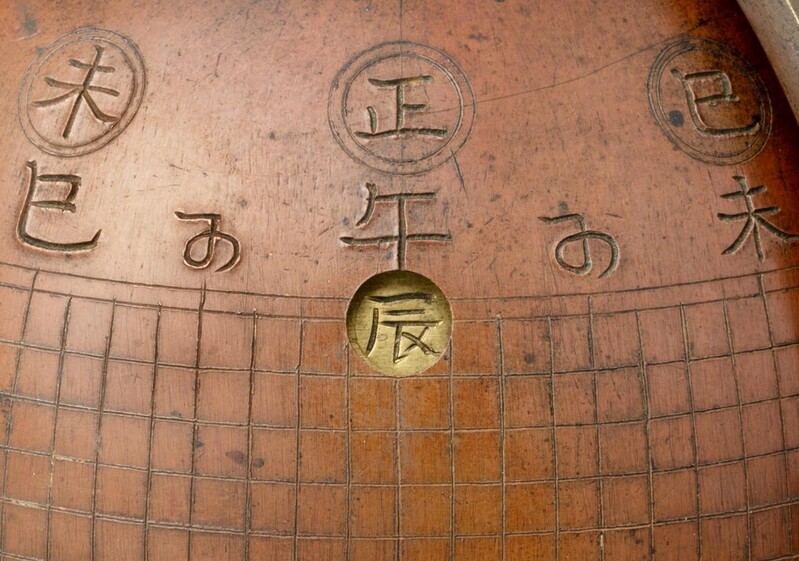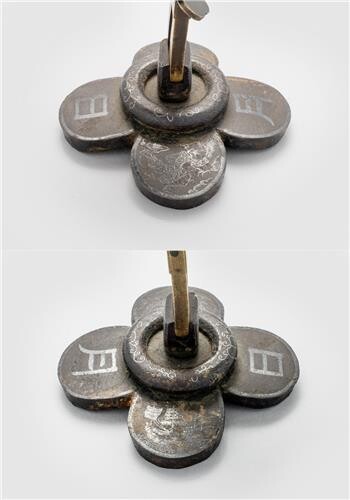 | |
|
 |
| ▲ This photo, provided by the Cultural Heritage Administration, shows the CT picture of the parts of "Iryeongwongu." (PHOTO NOT FOR SALE) (Yonhap) |
 |
| ▲ This photo, provided by the Cultural Heritage Administration, shows the sibochang, which is a time indicating window. (PHOTO NOT FOR SALE) (Yonhap) |
 |
| ▲ This photo, provided by the Cultural Heritage Administration, shows the pedestal. (PHOTO NOT FOR SALE) (Yonhap) |
Seoul, August 18 (Yonhap) -- Sundials, that tells time through the shadow cast by the sun, has been in use for a long time. "Angbuilgu," which looks like a pot looking up the sky is one of them.
A sphere-shaped sundial of the late Joseon Dynasty, which was designed to allow the measurement of time in different regions returned to Korea. It is a new type of sundial that has been confirmed in Korea.
The Cultural Heritage Administration and the Overseas Korean Cultural Heritage Foundation announced on Thursday that they had purchased a portable sundial called "Iryeongwongu" at an auction in the United States in March and brought it into Korea.
The " Iryeongwongu" that has been brought to Korea this time, is evaluated as a rare relic that has not been known to the academic world. Angbuilgu, a representative sundial of the Joseon Dynasty, has a hemispherical shape, whereas "Iryeongwongu" has a spherical shape with a diameter of the sphere being 11.2cm and the dimensions having a height of 23.8cm. At the first glance, Iryeongwongu resembles a small globe.
This clock, which has the two hemispheres interlocked, is presumed to have measured time by adjusting various devices.
According to the review of the expert, when using "Iryeongwongu," it was leveled with a plumb line (piece of string with a weight attached to one end that is used to determine if something is perfectly horizontal or vertical) directed towards the north using a compass, and the latitude was set with the adjuster.
Although the current plumb line appears to have been lost, the device for centering it remains on the base plate.
In addition to its unique shape, this clock is evaluated as an important relic historically and scientifically.
"Unlike 'Angbuilgu,' which could only be used in one region, 'Iryeongwongu' was produced in a way that could check the time in any region, and thus, is an important relic which shows the level of development of science and technology during that time," said the Cultural Heritage Administration.
On one of the hemispheres, it was marked with ninety-six vertical lines and an inscription of the twelve animals of the zodiac as a indication of time, in accordance with the time system used during the late Joseon Dynasty that divided the day into twelve hours and nintey-six gak (one gak= fifteen minutes).
"Seeing that Jagyeongnu (Clepsydra) of Changgyeonggung Palace and the Honcheonsigye (Armillary Clock), both of which have been designated as National Treasures, were also equipped with devices indicating time in accordance with the twelve animals of the zodiac system, it is indicated that while it inherited the science and technology of the Joseon Dynasty, it was newly designed for use outside of Korea as it began increasing exchanges with foreign countries," explained the Cultural Heritage Administration.
It also gained attention as the repatriated item is a scientific relic with a known producer and knows exactly when it was created.
In "Iryeongwongu," there is the inscription reading "newly produced at the beginning of the seventh lunar month of the gyeongin year which corresponds to the 499th year of the founding of the Joseon Dynasty" along with a seal that says "seal of Sang Jikhyeon," which indicates that the sundial was produced by a person named Sang Jikhyeon in the seventh month of 1890.
According to The Annals of King Gojong (Gojong Sillok) and Daily Record of the Grand Secretariat (Seungjeongwon ilgi), Sang Jikhyeon was a military official who was active during the reign of King Gojong. His son Sang Un is known as the fisrt person to bring a telephone to Korea after being dispatched to the Qing dynasty
Casting techniques and decorative elements that reflect the characteristics of the late Joseon Dynasty also stands out.
The base, made in the form of four petals, is inlaid with designs of dragon, a sailing ship, and the letters "日" (sun) and "月" (moon) using the inlay technique. It is a method of digging the pattern on the surface and filling the inside with silver, or other materials.
The Cultural Heritage Administration and the Overseas Korean Cultural Heritage Foundation participated in the auction at the end of last year after conducting a data investigation and review by the evaluation committee upon first obtaining information on its auctioning late last year. The purchase money was made using the lottery fund.
On the website of the auction house, the sale price is listed as 68,750 dollars, about 90 million Korean won.
Although it is not known how it went abroad, the item was auctioned off by a private collector who had acquired it from the bereaved family of U.S. military officer who had been stationed in Japan in the 1940s.
"The Iryeongwongu will be shown to the public at the National Palace Museum of Korea as a part of the special exhibition, 'Treasures of Ours, Treasured by Others: Journey of Korean Cultural Heritage' from August 19," said an official from the Cultural Heritage Administration.
(This article is translated from Korean to English by Haemin Kim.)
(END)
(C) Yonhap News Agency. All Rights Reserved

























![[가요소식] 보이넥스트도어, 신보로 3연속 밀리언셀러 달성](/news/data/20251025/yna1065624915905018_166_h2.jpg)








